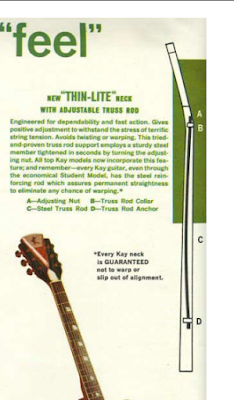Department Store Guitar Neck Reinforcements
 |
| 1965 Harmony Stella, Credit: Jake Wildwood |
What does it mean?
Sometime in the early 20th century the big guitar manufacturers realized that as people moved away from gut and towards steel strings that the guitars would be subject to more stress and tension so the designs would have the change. Martin began reinforcing their guitar necks with an ebony bar around the 1920s and it continued until 1934 [1]. Then they began constructing their guitars with a steel bar shaped like a T for stronger support without having to acquire exotic woods [2]. Then in 1967, Martin switched again to a hollow rectangular tube of steel inlaid underneath the fretboard to provide more strength than a thinner bar but without the weight of a solid bar [1]. Then in 1985, Martin settled on using an adjustable steel rod which supported the neck while also allowing the amount of relief in the neck to be increased or decreased [2]. Nowadays, most guitars, including the cheap Chinese ones, have an adjustable rod of sorts which allows for better playability and adjustment long term.
 |
| 1961 Catalog Scan from KayVintageReissue.com |
Most Kay guitar models are built with poplar necks with the higher models having more quality woods such as mahogany and maple. Poplar is a domestic hardwood that is fairly cheap yet still sturdy; maple outperforms poplar by miles for guitar construction though it is more expensive. From what I'm able to deduce (using catalog scans), 1961 was the transitional year where Kay switched from dovetailed neck joints to bolt-on necks and advertised their "Thin-Lite" adjustable neck. I cannot find any reference to an adjustable neck before that year and would appreciate any corrections on the topic. Usage of the Thin-Lite in neck construction slowly spread to more models but the cheaper models still lacked it.
 |
| Comparison of some of the steel bars I have lying around |
All the bars pictured above came out of guitars I have worked on, some are still apart and so I'll put the rod back when I reassemble the instrument. I don't have an incredibly large sample size to pull from but I thought it was interesting that the Harmony had a slanted end on its steel rod. All the rods need (or needed) some hammering to straighten them out as they were either put in wonky or warped over the years.
These steel rods were inlaid into the necks of the guitars they came out of and are the only thing fighting against the tension of the strings to keep the neck straight. The string tension always wins and so you end up with warped necks due to either the wood compressing under the rod or the rod bending or even a little of both. Once these necks are warped they cannot be adjusted and either have to be sanded level and refretted, fretted with larger fretwire in hopes of compressing the board back, or having the fretboard remove and refitted.
 |
| A truss rod from a Kay Speed Demon that had broken and needed to be removed |
This rod came out of my Kay Speed Demon after I removed the Indian rosewood fretboard. I knew my truss rod was broken as when I turned the nut the entire rod turned with it which would indicate that it had broken loose somewhere and was no longer applying tension to the rod.
Its made of a long steel rod with threads at one end and a flat head at the other, similar to a nail. The rod is held in place by the two semi-circle washers which sit in slots cut into the poplar neck that hold the rod in place. At the tail end of the rod, the washer has a square hole and is supposed to be welded to the flared end of the rod which keeps it stationary. Then at the head end there is a free floating washer which pushes against the wood when the brass nut is tightened which causes the rod to bow upwards. I was surprised to see that the truss rod channel was cut too deep for the rod in both of my Speed Demon projects. Kay remedied that by placing a 3/4" long wood shim in the center of the rod which contacts the fretboard to apply the pressure.
My discovery was that the weld at the tail end had broken and so the rod turned freely between both washers and was not able to be tightened causing the neck to remain warped and unadjustable. So I took to my two separating knives and using a household iron on the frets I took the fretboard off. It went very well up until the tail end of the guitar where the neck became thicker (to accomodate the bolts) and the truss rod stopped resulting in more poplar to heat. That part did not come off as clean and will require touching up later.
My new plan is to take a modern truss rod from LMII and affix it into the guitar in hopes of keeping this guitar playable for far longer than the original rod did.










Hi! Check out the crazy trussrod on the kay sizzler k 4144. / Mats Bohlin
ReplyDelete